Introduction
The Conquest metagame is an environment in constant evolution, with a wide range of commanders, players and strategies battling for dominance. In this article, we will look at some of the numbers and trends of the metagame regarding the format's Commanders, based on data collected from early 2022 until the end of December compiled here, addressing the biggest Conquest communities in Brazil (São Luís and, mostly, Brasília) and also in Conquest Brasil's online events.
For those who are not familiar with the Conquest format, the same was already addressed in one of Cards Realm's own article, here, from Felipe "Fells" Torres. From this publishing until today, there were a few updates in the banlist and the addition of the Scry rule.
Overall Numbers
According to the data, there were 364 different commanders, 186 unique players and 69 tournaments, adding up to a total of 1037 games at the base. This means that, in average, there are approximately two different commanders per player, indicating a high level of deck variety and experimentation.
It is a diverse and dynamic environment, with a wide range of commanders, players and strategies. The data compiled in this analysis offer a cut of the current metagame and will be useful for players that are trying to understand trends and patterns that might form the metagame in the future.
The data analysis made here is based on two axes: popularity and win rate.
Note that in the deck-by-deck analysis, decks with less than 10 games were disregarded due to low volume. Players with a win rate below 10% were also removed to minimize the effect of inexperienced players in the results. As reference for the graphs, win rate is represented by the turquoise color, loss rate is in gray and draw rate is in orange.
High Popularity Commanders
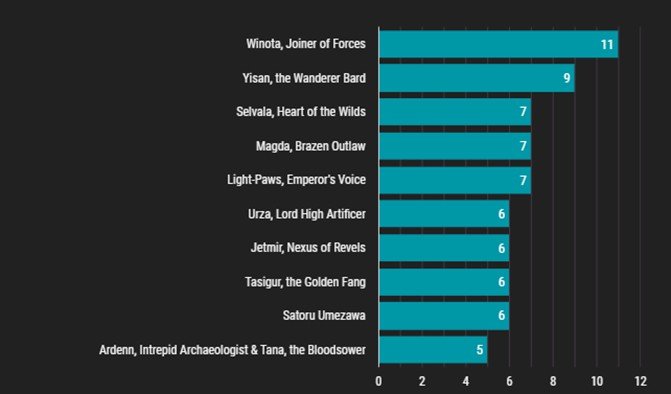
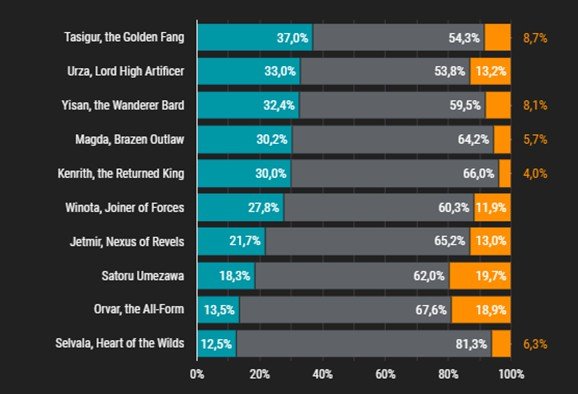
The most popular and successful commanders (with at least 10 games played) are Winota, Joiner of Forces, Urza, Lord High Artificer, Yisan, the Wanderer Bard, Tasigur, the Golden Fang and Magda, Brazen Outlaw. This is not surprising because these commanders are easily ported and adapted from cEDH.
An interesting aspect of the data is the prevalence of mono-colored commanders in the top popularity rankings. This suggests players are having success with more focused, streamlined decks, rather than trying to incorporate a wide range of colors.
Another notable aspect is the variety in the archetypes represented among the most popular commanders. There are decks of all macroarchetypes: Aggro, Control, Midrange and Combo. This showcases the versatility and adaptability of the format.
The absence of Storm strategies (including Farm, decks based on Ad Nauseam and Peer Into the Abyss) among the most popular commanders is a surprise. These strategies, which rely on building considerable amounts of resources and, afterward, triggering a powerful combo, many times are seen as dominant in other formats. However, it seems they are not that popular here.
Some unexpected commanders who performed well in the format include Jetmir, Nexus of Revels, Light-Paws, Emperor's Voice, Ardenn, Intrepid Archaeologist & Tana, the Bloodsower. These commanders might not be as well-known as some of the others in the list, but they proved themselves to be formidable in the right hands.
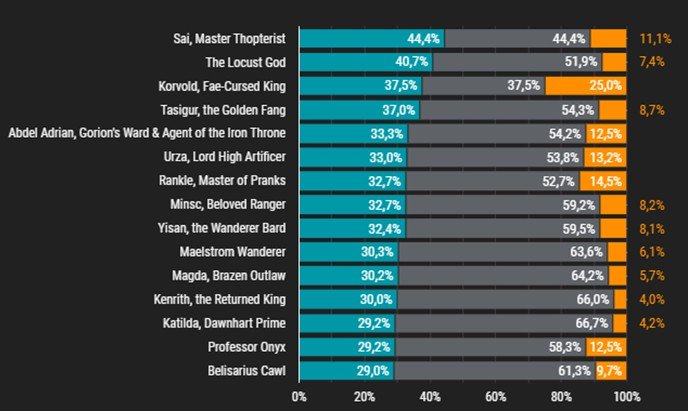
Many players specialized themselves in and optimized certain commanders such as Sai, Master Thopterist, The Locust God, Korvold, Fae-Cursed King, Rankle, Master of Pranks, Maelstrom Wanderer, Katilda, Dawnhart Prime, Professor Onyx and Belisarius Cawl.
On the other hand. commanders such asTasigur, the Golden Fang, Magda, Brazen Outlaw, Urza, Lord High Artificer and Kenrith, the Returned King showed consistency in their performance in a wide variety of players and decklists. This suggests these commanders are strong and flexible enough to work in a variety of different strategies.
Low Popularity Commanders
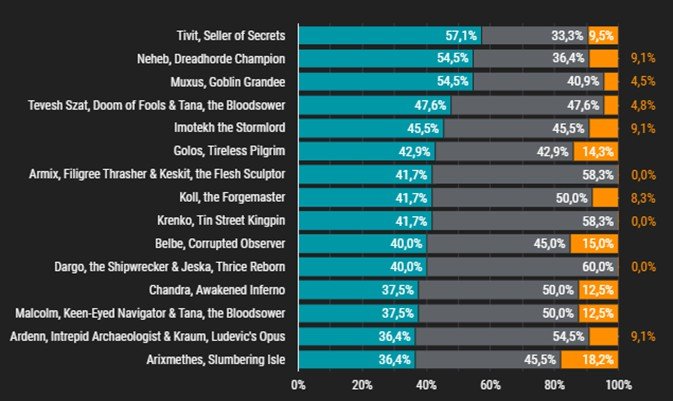
There are many low popularity commanders who have reached high win rates. One of these commanders is Tivit, Seller of Secrets, which has always performed well, though it is not a well-known or widely played commander.
A great portion of low popularity commanders with high win rates are Mono-Red or Red-based decks. Out of the 15 commanders in the list, 10 of them are primarily Red. This suggests that Red, frequently seen as an aggressive and powerful color, is particularly well-suited for this format.
Many of the unpopular commanders with high win rates are also combo decks. These decks might be hard to play, and require careful planning and execution, but when well-done, they can be incredibly effective
Another common theme among the unpopular commanders with high win rates is the "one player hero decks", which are decks with uncommon commanders, but with a highly specialized player piloting it and extracting the most of it.
Decks - Planeswalker Commanders vs Non-Planeswalker Commanders
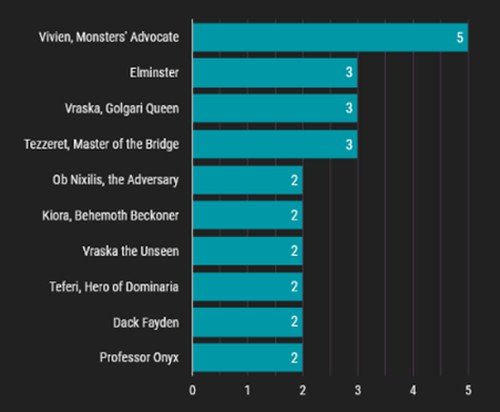
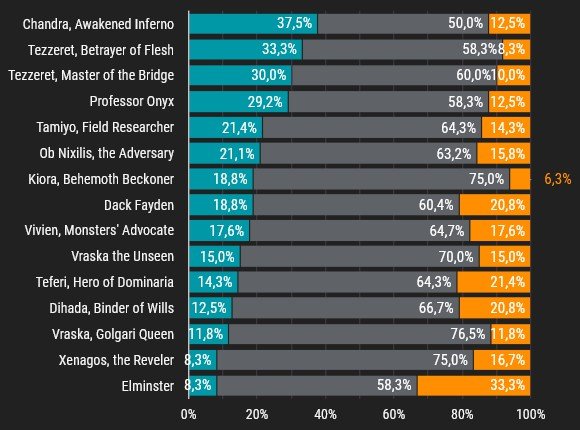
Planeswalker commanders have an average win rate of 19,51%, whereas non-planeswalker commanders have an average win rate of 23,15%. This suggests that, in average, non-planeswalker commanders are more successful in Conquest.
It is important to note, however, that this data is based on a sample size relatively small and may not be representative of the overall metagame. Besides that, each planeswalker and non-planeswalker's specific traits might have a significant impact in their individual win rates.
Color Performance
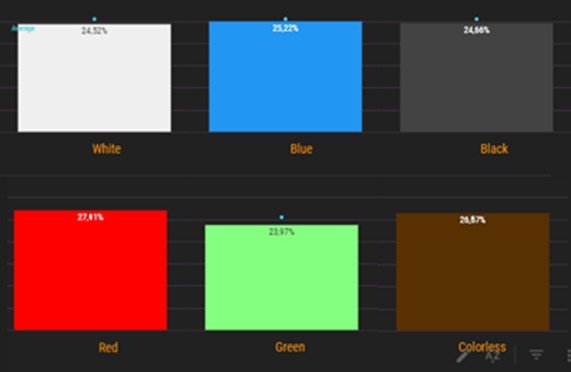
As the color composition of a deck can have a significant impact in their performance, this part of the article analyzes its impact in the performance of the decks in the sample.
It is important to note that in this part of the analysis, though we separated the 5 colors (and colorless), we are analyzing composition and not just mono-colored decks, so, a deck like Esper is Black, White and Blue.
| Color | Win Rate % | Relation to Average Win Rate |
|---|---|---|
| White | 24,52% | -3,99% |
| Blue | 25,22% | -1,25% |
| Black | 24,78% | -2,98% |
| Red | 26,94% | 5,48% |
| Green | 24,07% | -5,76% |
| Colorless | 26,67% | 4,42% |
Color Win Rate % Relation to Average Win Rate
White 24,52% -3,99%
Blue 25,22% -1,25%
Black 24,78% -2,98%
Red 26,94% 5,48%
Green 24,07% -5,76%
Colorless 26,67% 4,42%
These results indicate that Red stands out, with a significantly higher win rate compared to other colors. In contrast, Green and White tend to have the lowest win rates. This can be due to the low density of good cards in White compared to other colors, as well as the absence of the main tutors and some ramp in Green. It is justified also due to the bigger number of Red decks on top, which deal well with decks based on small creatures, the bases of these two colors.
Blue and Black, though low in average due to Red, get closer to this line. Overall, the lack of generic win conditions in other colors besides Red can also be a factor to their low win rates, but we will talk about this in the future.
Curiously, colorless decks performed well, but we do not have enough data to draw consistent conclusions, and it would be hasty to do so.
Performance by Number of Colors in a Deck
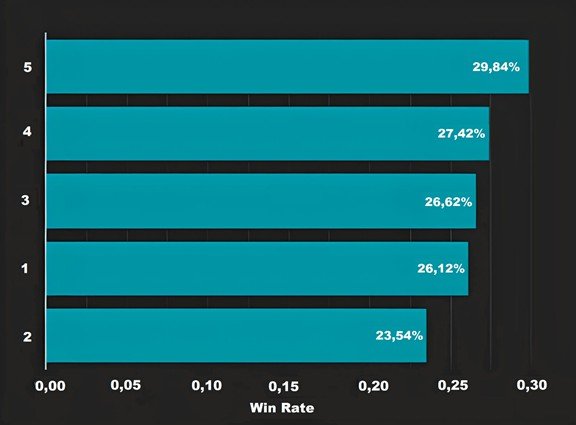
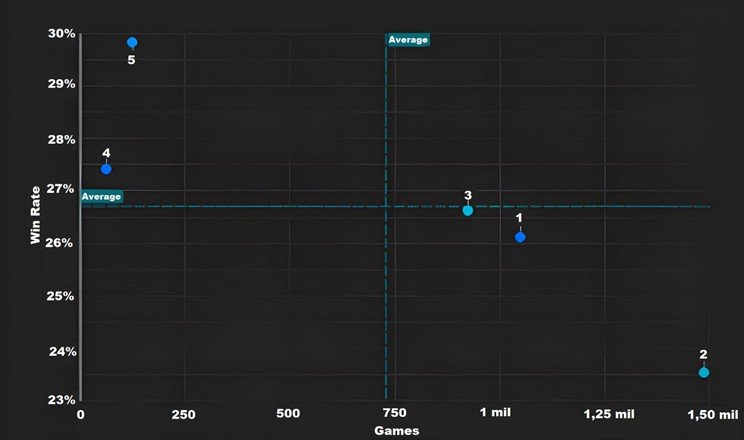
According to this analysis, the win rate of decks increases as the number of colors they carry increases.
A possible explanation for this trend is that the mana base in the format is not particularly punishing, even without access to fetch lands or dual lands. This allows players to build decks with a higher number of colors without being severely hindered by the cost of casting their spells. Besides that, having access to a wide range of colors may enable players to include more efficient win conditions in their decks, which might give them a significant advantage in longer games.
This pattern is broken when two-colored decks have a lower win rate than mono-colored decks. A part of this is due to the mono-colored commanders many times being stronger individually than two-colored commanders because they can focus on a single color's strengths and synergies. Besides that, the incredibly high popularity of two-colored decks causes this win rate to free fall, as there are a wider range of players piloting these decks.
As for the low diversity of four-colored commanders, it is in part due to the lack of prints in these combinations and also due to the limitation of their partners, as Thrasios, Triton Hero and Tymna the Weaver are banned as commanders, which limits the popularity of four-colored decks in this format.
Besides that, naturally, decks with more colors tend to be more financially expensive, which explains why 5C and 4C are less popular (and why they potentially have a significantly higher win rate).
Performance of Mono-Colored and Colorless Decks
The mono-colored decks' win rates are the following:
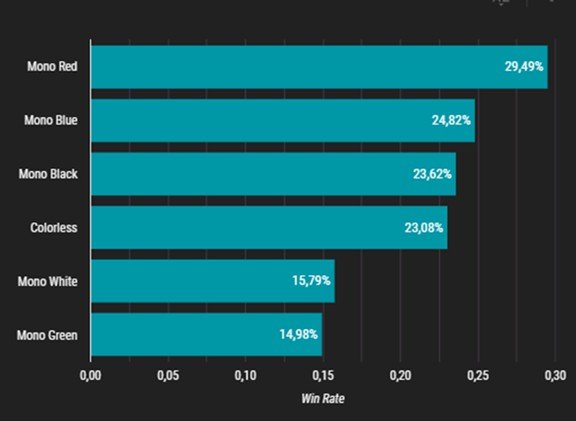
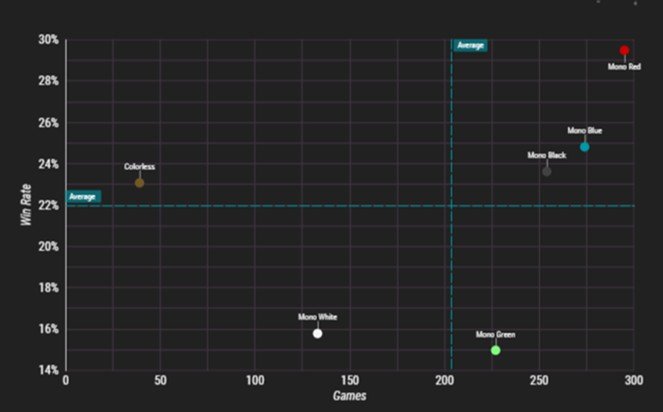
Mono-Red
Mono-Red is performing relatively well, with a higher than average win rate and a relatively high level of popularity.
Mono-Red commanders are efficient in providing good win conditions and benefit from Conquest's 30 starting life total. Muxus, Goblin Grandee and Krenko, Tin Street Kingpin make clear the strength Goblin tribals might have in this format and are commanders who attack from multiple angles (in particular Muxus): commander damage, aggression by number of creatures and combos.
Though he is not a tribal, Neheb, Dreadhorde Champion also performs excellently and can deal massive commander damage and allow combos to have explosive turns.
Chandra, Awakened Inferno performed well and already entirely changes archetypes, allowing an efficient board control strategy with plenty global spells, all while it places emblems and puts a turn counter for opponents.
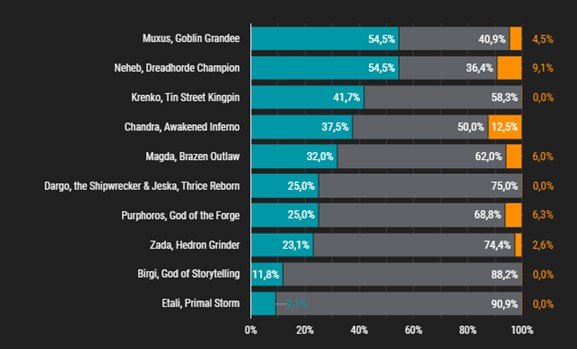
Mono-Blue and Mono-Black
It appears that Mono-Blue and Mono-Black are relatively healthy, with close to average win rates. These colors can draw upon a wide range of strategies, including expressive card advantage, disruption and commanders with varied abilities.
We can note that they perform well with artifact-based strategies, such as Krark-Clan Ironworks and Paradox Engine, as is the case of Sai, Master Thopterist, Urza, Lord High Artificer, Tezzeret, Betrayer of Flesh, Imotekh the Stormlord and the duo Armix, Filigree Thrasher & Keskit, the Flesh Sculptor.
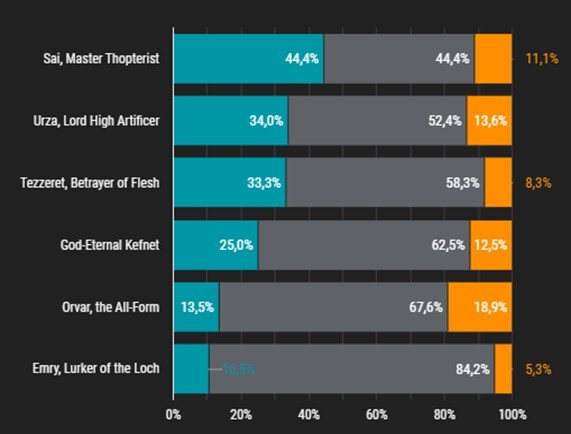
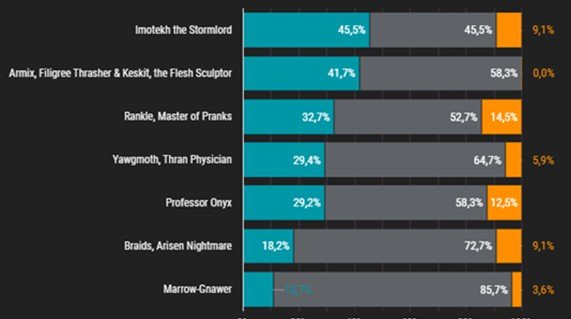
Mono-White
According to our data, players are not dedicating time to Mono-White decks or even to dominating commanders in these colors, which reflects itself in the low win rate and an even lower popularity rate.
Though, it is worth noting, Light-Paws, Emperor's Voice might a consistent Voltron deck alternative (decks based on commander damage).
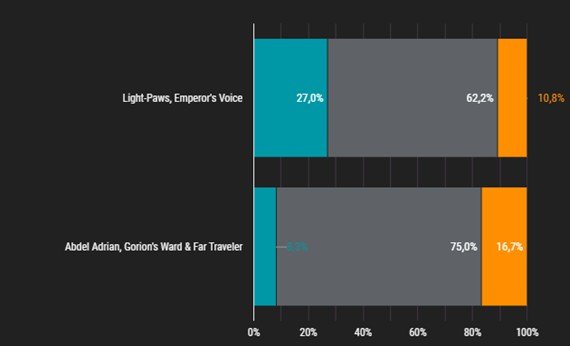
Mono-Green
Mono-Green, on the other hand, is more popular, but has a win rate even worse than White.
As said previously, possibly due to the absence of the main Green tutors and ramps. The color bases itself too much on mana dorks and ends up suffering in the hands of the best color in the format, Red, which abuses Pyroclasm-like effects. Besides that, these decks lack efficient win conditions, except for Yisan, the Wanderer Bard in the command zone.
The absence of commanders such as Ashaya, Soul of the Wild and Ezuri, Renegade Leader, potentially strong, might be contributing to Mono-Green's poor performance.
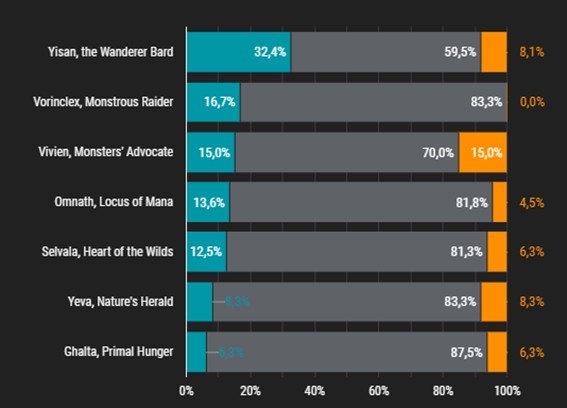
Colorless
Curiously, though they have a win rate which is much bigger than White's and Green's, colorless decks still have inherent difficulties due to the lack of colors, such as an absence of good answers and a high dependency on artifacts.
There is not enough considerable data to draw bigger conclusions, but it is worth noting the great potential of Ugin, the Ineffable based on Krark-Clan Ironworks strategies.
It is also important to note that Kozilek, the Great Distortion, though its low win rate in the data, possibly in part due to inexperienced pilots, was champion of the first edition of the Conquest Cup.
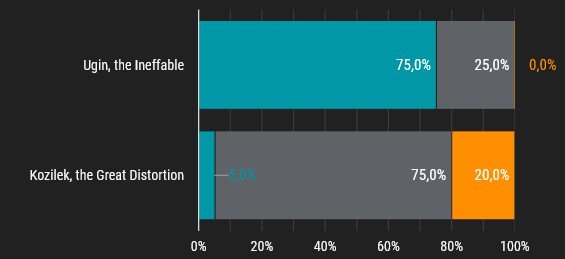
Performance of Two-Colored Decks
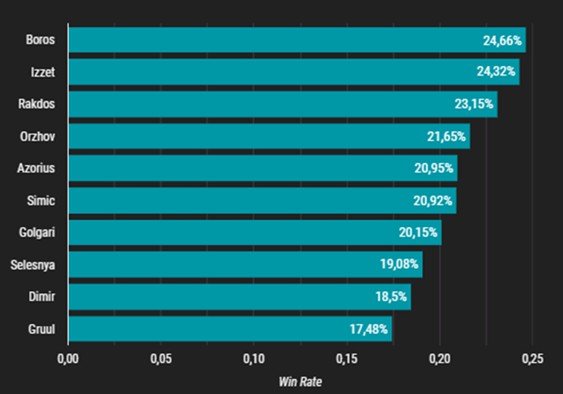
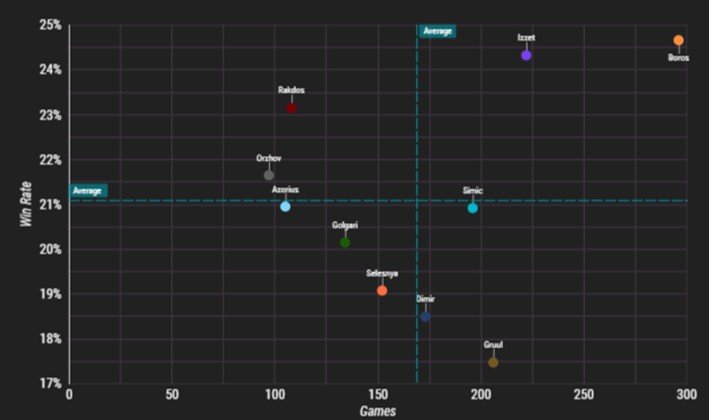
Two-colored decks are a diverse and popular group, featuring a wide range of possible commanders. According to the data, the top 3 best well-positioned combinations have Red as its main color: Boros, Izzet and Rakdos, with Boros and Izzet benefitting from very high win rates.
Boros decks are diverse, with a variety of archetypes represented among the main ones. Winota, Joiner of Forces is the most popular commander in this group and is more popular than all other Boros commanders combined. And though her popularity, she goes against what is expected and keeps an above-average win rate.
It is possible the dominance of Winota is taking out diversity inside this combination, as it can fit both in Hatebears (an archetype with disruptive creatures) and Linear Aggro strategies.
Still in Boros, it is worth nothing the nice above or close to average performance of commanders in general, in particular Koll, the Forgemaster, a combo deck based on equipment.
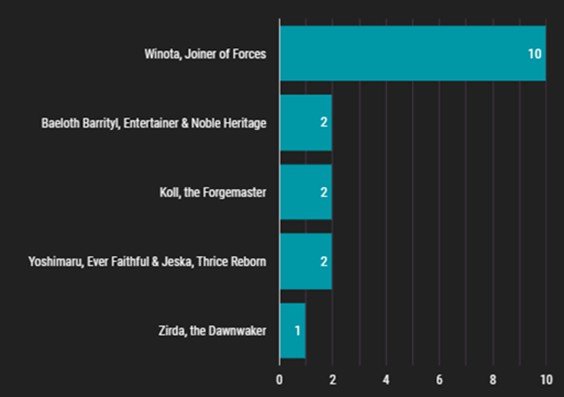
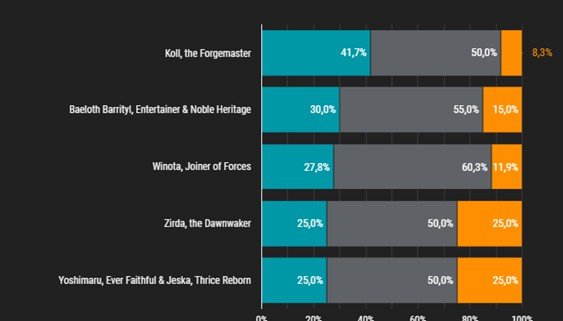
The absence of the duo Krark, the Thumbless & Sakashima of a Thousand Faces and Rielle, the Everwise and Niv-Mizzet, Parun due to the low number of games, is notable and definitely affects the overall win rate, as they are potentially very strong and unexplored decks.
Among the highlights we see in the graph, we have The Locust God(with an extremely dedicated pilot) and Jeska, Thrice Reborn & Kraum, Ludevic's Opus combos, a very efficient Voltron Control, which allows, with both commanders, dealing 12 commander damage in one single attack.
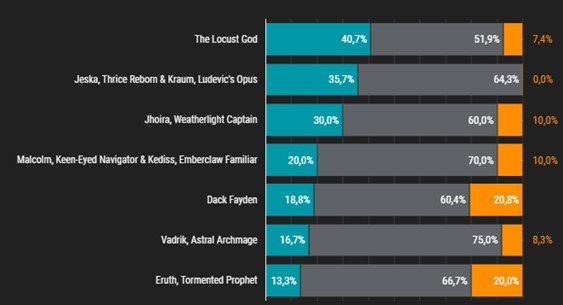
Skipping to the lower part of the two-colored deck's performance graph, Gruul gets a negative highlight, even though it uses Red. With a win rate that is lower than the other three Red-based decks, it is a combination frequently used by new players and/or "Timmys" (the profile of players who enjoy big creatures and are closer to casual play).
The commanders are well distributed into different archetypes and here there is space for highlighting Blanka, Ferocious Friend, a nice Voltron, and the only Grull to have an above-average win rate.
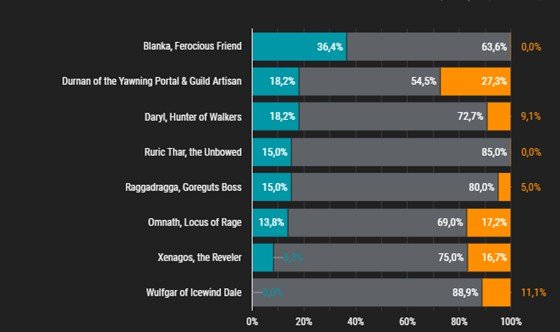
Another point to observe in the graph with the 10 two-color combinations is that Green is represented among the bottom five decks, with all four different two-colored decks featuring this color. Another member of the "bottom five" are Dimir decks, which suffer from the lack of good generic win conditions. Satoru Umezawa is a popular Timmy-style commander in this group, but in terms of win rate the only deck above it is Tezzeret, Master of the Bridge, based on artifact combos.
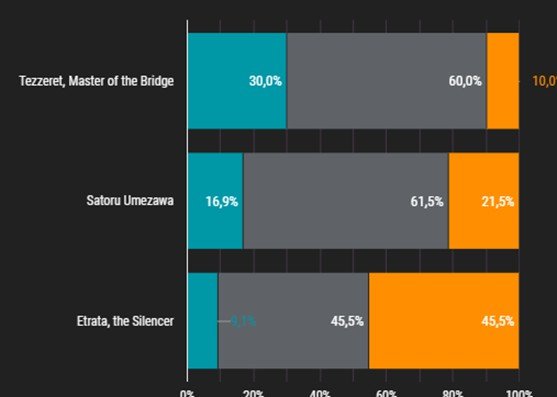
Performance of Three-Colored Decks
Three-colored decks are a popular and efficient group, featuring a wide range of strategies and playstyles.
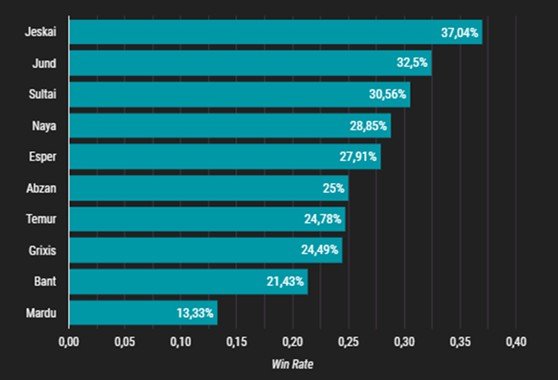
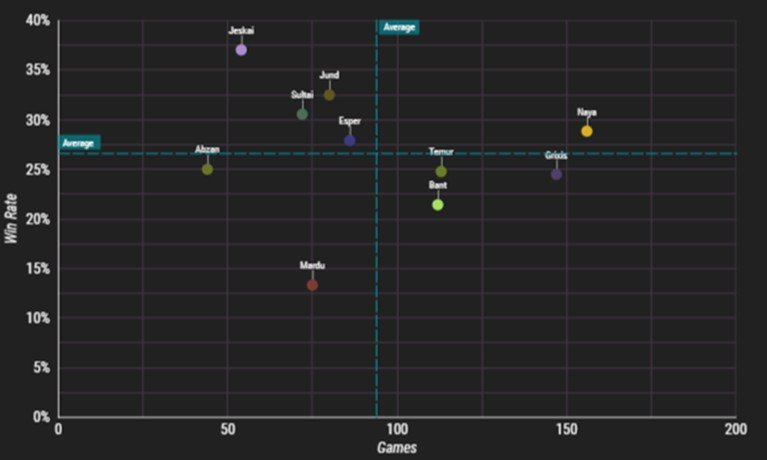
The colors in these decks are well-distributed, with just Bant and Mardu having win rates below the overall average.
It is surprising to see both Grixis and Mardu with low win rates, as they perform well in the cEDH format. For Grixis it might be a matter of list adjustments, as Izzet still performs well.
As for Mardu, it loses its top commanders in Conquest, Tymna the Weaver and Rograkh, Son of Rohgahh, whereas Abzan loses popularity without Tymna and relies more on commanders such as Kodama of the East Tree & Ravos, Soultender and Tayam, Luminous Enigma, which are win conditions in the command zone with a deck structure based on Hatebears.
The best three-color combination is Jeskai. The combination loses a bit of its power in Conquest, with many decks featuring win conditions in the command zone and solid combo lines with Underworld Breach and Dualcaster Mage as backup plans. In this combination, the best win rate is in the hands of Ardenn, Intrepid Archaeologist & Kraum, Ludevic's Opus.
The best well-positioned Jund decks are mostly in "Farm" style Storm decks (based on Ad Nauseam), projected to win as fast as possible and use their commanders to grind value, such as Korvold, Fae-Cursed King and the partners Tevesh Szat, Doom of Fools & Tana, the Bloodsower.
Sultai is represented by just one deck with a decent win rate, Tasigur, the Golden Fang.
Esper is dominated by Tivit, Seller of Secrets. Just for measure, without this commander the win rate of this combination would fall to 19% from 27,91%.
Temur, on the other hand, has remained healthy in terms of number of available commanders. Among its main representatives we have Malcolm, Keen-Eyed Navigator & Tana, the Bloodsower, Maelstrom Wanderer and, unexpectedly, Miirym, Sentinel Wyrm.
Performance of Four and Five-Colored Decks
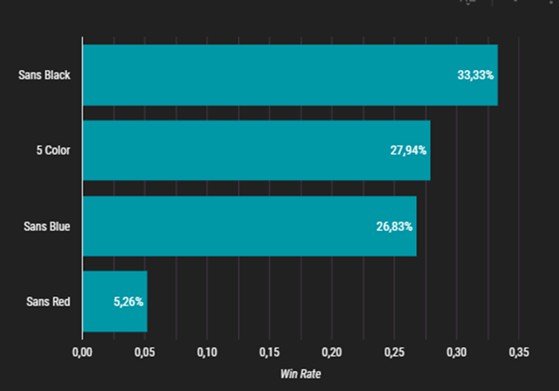
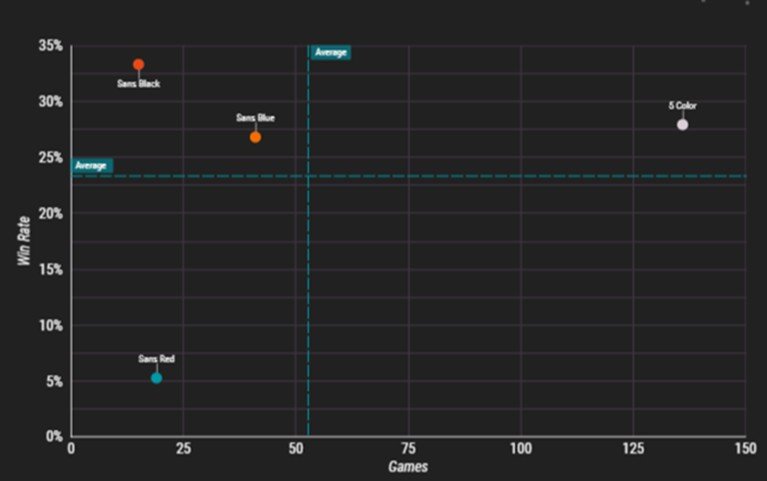
The mana base appears to be working well for these decks, allowing for players to effectively incorporate a wide range of colors into their strategies. However, there is the absence of two variations of four-colored decks, sans Green and sans White, which might be a sign of a limitation in the metagame in these combinations, in part due to the banlist, but mostly due to the lack of options in these combinations.
Despite these challenges, four-colored decks are performing above the average win rate for all decks in the format, just like five-colored decks, which are popular and have a wonderful win rate of 29%, particularly with Golos, Tireless Pilgrim and Kenrith, the Returned King in the command zone.
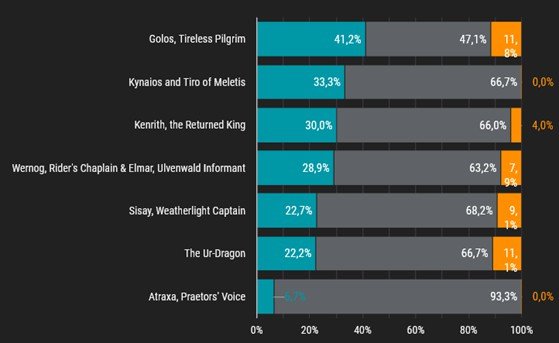
Final Thoughts
We have come to the end of our first part of this analysis. I hope it was a rich reading and that it can be fruitful for players that want to extract the most potential out of this format. It is worth remembering Conquest is changing constantly due in part to being a vast environment to be explored, which in turn provides great experimentation potential for players, which reflects itself in the metagame data.
About the current format, the updated banlist and the format's rules can be seen here.
For the next article, I will bring the data related to the Conquest Staples. Keep up with Cards Realms to see it!
See you next time!

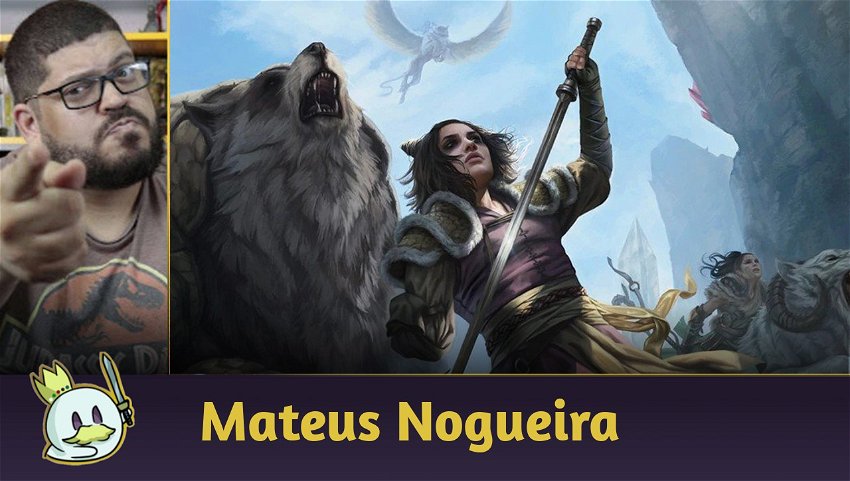







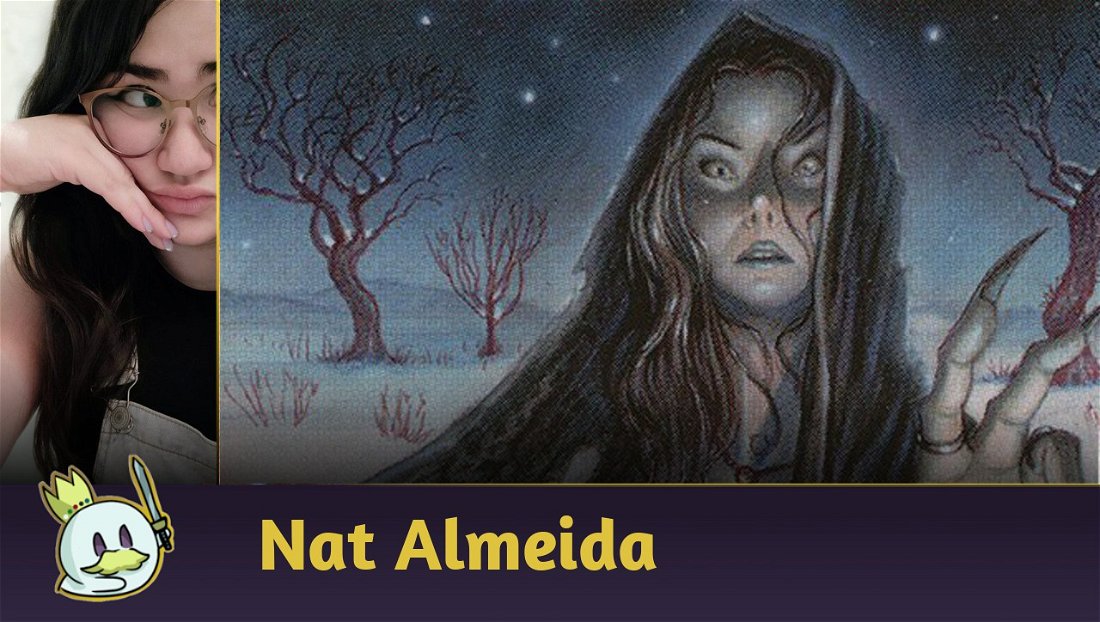
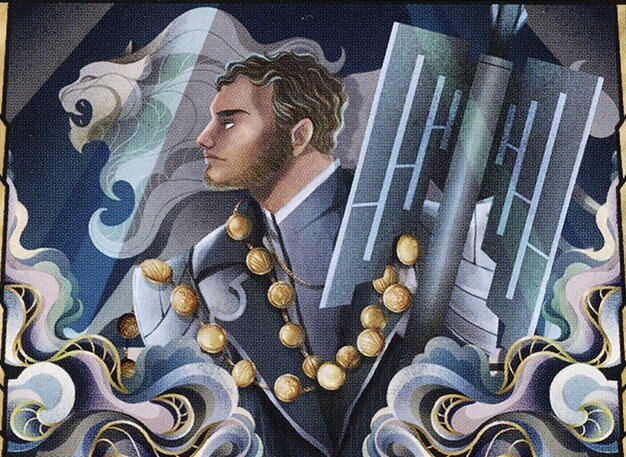



— تعليقات 0
, ردود الفعل 1
كن أول من يعلق